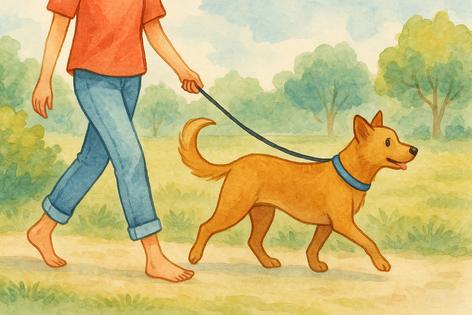Dog Walking Etiquette: How to Keep Walks Safe, Pleasant and Neighborly
Published in Cats & Dogs News
Dog walking looks simple from the outside: clip on a leash, step outside, and let the paws lead the way. But every stroll threads through public spaces, neighbors’ yards, and the routines of other people and pets. Good dog walking etiquette keeps those paths peaceful. It helps your dog stay safe, keeps your community clean, and ensures that everyone—from fellow dog lovers to the dog-wary—can enjoy their time outdoors.
Respect Personal Space
Not every person—or every dog—wants to be greeted. When you encounter another walker, always ask before letting your dog approach. Even a friendly dog can make others nervous, especially small children or older adults. Keep the leash short and under control until you get a clear yes.
The same goes for approaching other dogs. Some pups are reactive, recovering from injuries, or still in training. A quick, polite “Is your dog friendly?” goes a long way toward preventing leash tangles and sudden scuffles.
Control the Leash
Loose-leash walking isn’t just polite; it’s safe. Retractable leashes can let dogs dart into traffic or wrap around pedestrians. A standard six-foot leash keeps your dog close enough to guide while giving them room to sniff.
If your dog pulls, zigzags or lunges, practice leash manners during quieter hours. Structured walks with frequent direction changes can help. A well-behaved dog on leash makes the experience more pleasant for everyone who shares the sidewalk.
Clean Up Promptly
This might be the most basic rule, but it bears repeating: always carry bags, and always pick up after your dog. Leave No Trace applies to neighborhoods too. Failing to clean up not only spreads disease but erodes goodwill with your neighbors.
If you forget a bag, return later to collect it. Many parks and walking trails now offer bag dispensers—use them if needed. Responsible cleanup shows respect for the community and the environment.
Watch for Property Boundaries
While the grass along the sidewalk may seem fair game, it’s often part of someone’s lawn. Be mindful where your dog stops to sniff or relieve themselves. Encourage your pup to stay close to the curb or walk them on public easements rather than private yards.
If your dog damages a plant or digs in someone’s garden, offer to make it right. A small gesture of accountability keeps neighborly relationships intact.
Be Alert, Not Distracted
It’s tempting to check your phone while your dog sniffs the world, but staying attentive is part of good etiquette. Watch for cyclists, joggers, wildlife or off-leash dogs who might startle or provoke your dog.
A distracted walker can miss early signs of tension—raised hackles, stiff posture, a fixed stare—that could escalate. Staying present helps keep you both safe and allows you to respond calmly and quickly if needed.
Time and Place Matter
If your dog is vocal or reactive, avoid high-traffic times and narrow trails. Choose wide sidewalks, open parks or early morning walks to give them space to decompress.
Conversely, if your dog is sociable, busier times can provide enrichment and socialization opportunities—as long as you remain courteous and mindful of others’ comfort levels.
Keep Walks Positive
A walk is your dog’s chance to explore. Allow sniffing breaks and short pauses—they’re mental exercise as much as physical. Praise calm behavior and good leash manners.
By framing walks as shared adventures rather than chores, you build trust and make training easier. A happy, relaxed dog reflects well on you and encourages friendly interactions with others.
Be a Good Ambassador
Dog walking etiquette isn’t about rules for rules’ sake. It’s about showing the world that dogs and their humans can coexist gracefully in shared spaces. A well-mannered dog makes a lasting impression—and helps ensure that parks, trails and neighborhoods stay welcoming to dogs in the future.
The more care and courtesy you bring to every walk, the more your dog—and your community—benefit.
========
This article was created, in part, utilizing AI tools.









Comments